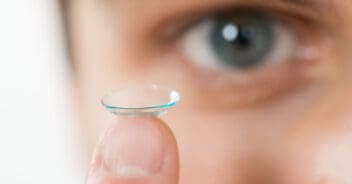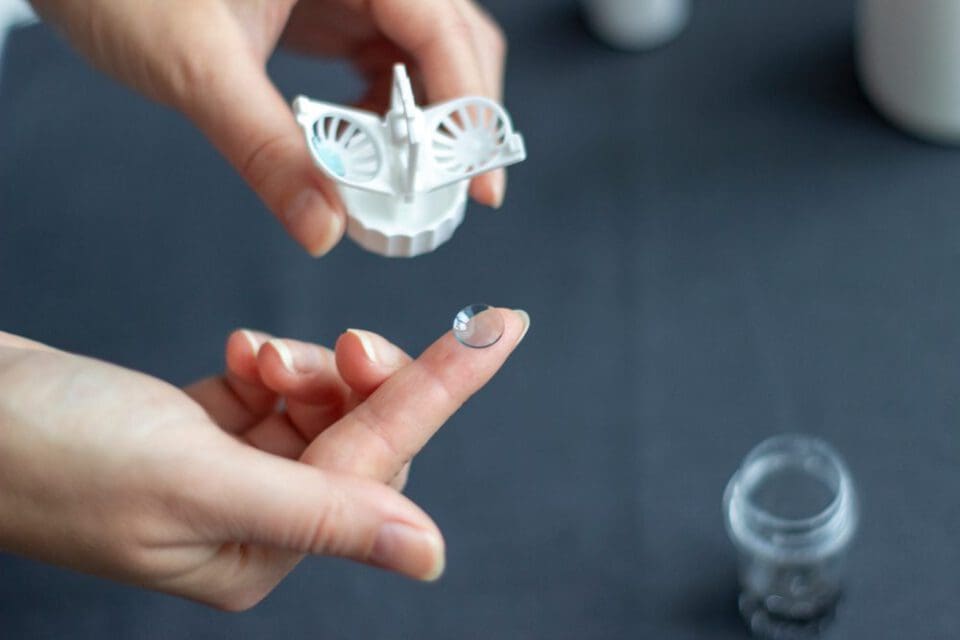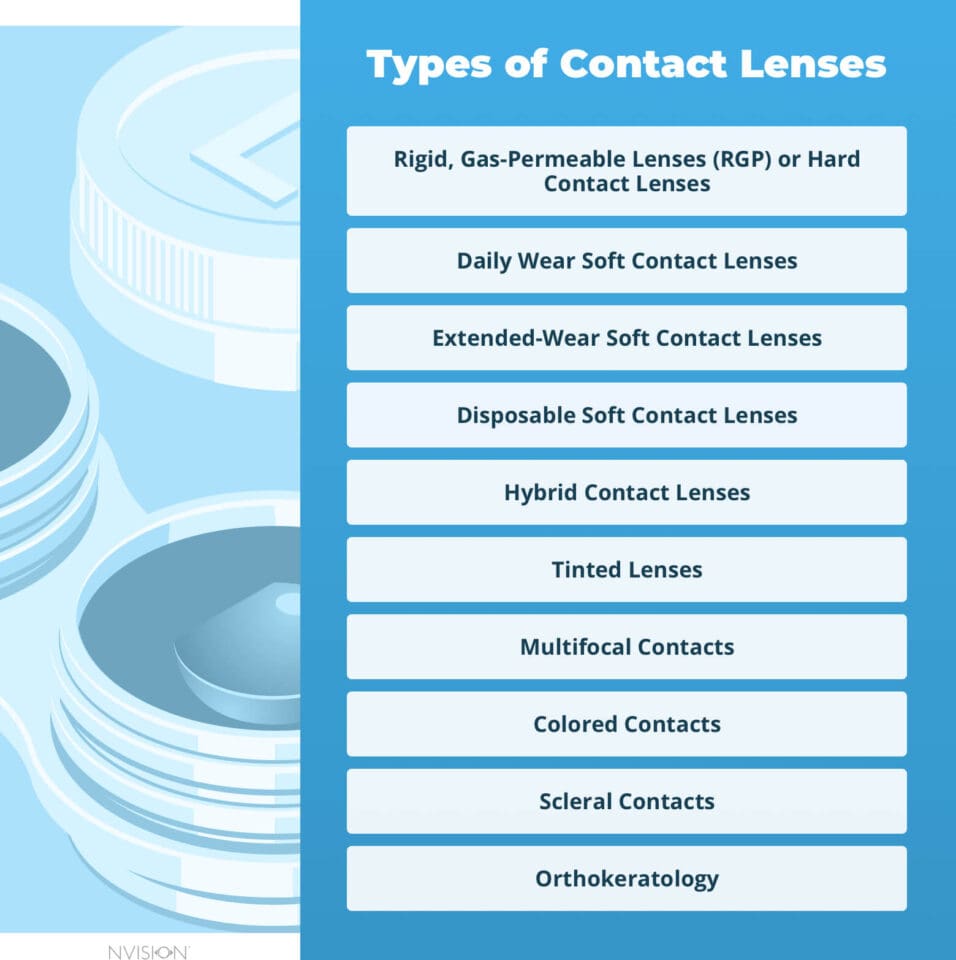Further Reading
Understanding Contacts: Are They the Right Solution for You?
Home /
Last Updated:
Aside from eyeglasses, contact lenses are considered one of the safest methods for correcting refractive vision errors. Some of the most common include myopia, or nearsightedness, and hyperopia, or farsightedness.
Table of Contents
Contact lenses are considered medical devices that correct common refractive vision errors, such as myopia (nearsightedness) and hyperopia (farsightedness). They can be a safe and effective way to correct vision in those with common visual impairments.
The Centers for Disease Control and Prevention (CDC) publishes that in the United States, around 45 million people wear contacts. Contact lenses are prescription-based and require a visit to an ophthalmologist to determine eligibility and to fit them.
There are several different types of contacts, including extended-wear contacts that can be left in for a little longer than daily use contacts, soft lenses, rigid lenses, disposable contacts, and reusable ones. To use contacts, you will need to be comfortable placing things into your own eyes. It is also important to take good care of your contacts, being sure to clean them properly, change them when directed, and follow your doctor’s directions on how to use them correctly.
Contacts have some risk factors, and they may not be ideal for everyone. Ultimately, contacts can be a wonderful tool for correcting vision. This guide can help you decide if they are right for you.
When to Consider Contacts
Aside from eyeglasses, contact lenses are considered one of the safest methods for correcting refractive vision errors. When you are nearsighted and suffer from myopia, for example, light is focused on the front of the retina instead of directly on it, which can make things in the distance seem blurry and out of focus. With hyperopia, close things appear blurry, as light is focused too far to the back of the retina.

Contact lenses are placed directly on the eye to change the refractive surface, and the National Eye Institute (NEI) explains that this can help you to focus better. Contacts may also give you a wider field of vision than eyeglasses since they sit directly on the eyes. Peripheral vision is therefore not obstructed. They also do not change your physical appearance and can seem more comfortable and aesthetically pleasing.
You deserve clear vision. We can help.
With 135+ locations and over 2.5 million procedures performed, our board-certified eye surgeons deliver results you can trust. Your journey to better vision starts here.
Contacts can be safer to wear while playing sports as they conform directly to the eye. Contacts are also not impacted by weather and will not fog up like eyeglasses can.
If you are suffering from a common refractive error that requires prescription eyewear, contacts can be a good option. The American Optometric Association (AOA) publishes that the majority of people who wear contacts do so to correct myopia, or nearsightedness. Contacts can also correct astigmatism and hyperopia too.
Steps for Getting Contacts

You can avoid vision complications by following the proper process to obtain your contact lenses. Here are the right steps:
- Get an Eye Exam: If you have any vision problem, such as refractive errors, only an eye exam can determine whether contact lenses are the right remedy for you. You will need to see an eye doctor to get a prescription.
- Get Fitted: After running the necessary eye tests, your doctor will figure out the right contact lens fit for your eyes. Fitting is necessary if you’ve never worn contacts before.
- Get Your Prescription: Your eye doctor will write you an appropriate contact lens prescription for your vision problem. You should ask for a copy of the prescription.

Understanding the Types
Not all contacts are the same. Your eye doctor can help you to decide which ones are going to be best for your eyes and your lifestyle. In general, the main differences in types of contacts are between soft and hard lenses as well as disposable and reusable ones.
- Rigid, gas-permeable lenses (RGP) or hard contact lenses: AOA publishes that RGP lenses are made of plastic that is slightly flexible and allows oxygen to pass through them relatively freely. They can be used to correct most refractive errors, including myopia and corneal refractive therapy. They also come in bifocals where both hyperopia and myopia are corrected for in the same lens. RGP lenses provide some of the highest quality of refractive error correction and therefore visual clarity. The eyes typically take a little time to adapt to them, and they can be easy to care for and use. RGP lenses are reusable. They can have a long life of a few years if your prescription remains the same and they are properly cared for. They do need to be worn consistently for the eyes to adapt to them. It may be easier than with other lenses for dirt particles to get underneath them and for the lenses to slip off the center of the eye.
- Daily wear soft contact lenses: These are typically some of the least expensive contact lenses. They can correct for myopia, hyperopia, astigmatism, presbyopia (age-related hyperopia), and corneal irregularities. Mayo Clinic reports that your eyes are more apt to adapt to soft contacts quicker than rigid ones, and most people wearing contacts opt for soft lenses. Daily wear soft contact lenses need to be taken out and cleaned every night and will need to be replaced at specific intervals as they will wear out. Vision may not be as sharp with daily wear soft lenses as with RBP lenses. However, they are typically considered to be more comfortable, good for an active lifestyle, and harder to dislodge.
- Extended-wear soft contact lenses: These soft contact lenses can be worn for a few days and possibly even up to a week. Leaving them in overnight does increase the potential risk for eye infection. They do need to be cleaned at least once per week at the minimum. Most are approved for seven-day use, and there are even some extended-wear lenses that may be able to be left in for longer. They will require more follow-up office visits and monitoring to ensure their safety.
- Disposable soft contact lenses: Disposable lenses are thrown out; therefore, they do not need to be cleaned and disinfected. They are used for the specified length of time, which may be a day, a week, or a month. Then, they are discarded and replaced with new ones. These types of contact lenses can be more expensive since you will need more of them more often. They can be more convenient, however.
There are also specialized contact lenses in the form of hybrid lenses, tinted lenses, and bifocals. Hybrid contact lenses are a combination of hard and soft lenses, typically with a hard RGP center and an outer ring that is soft and more flexible. Tinted lenses can help to correct color perception or contrast, and they can also be tinted for cosmetic purposes.
It is important to remember that all contact lenses are prescription-based. Over-the-counter tinted lenses are not considered safe to put in your eyes.
Other Types of Contacts
- Hybrid contacts: These lenses comprise a firm, oxygen-permeable material in the middle and a soft outer ring. They can repair refractive errors like nearsightedness, farsightedness, and distorted vision.
- Multifocal contacts: These lenses can also correct refractive errors in your vision.
- Colored contacts: Tinted versions of prescription contacts may improve color perception in colorblind patients.
- Scleral contacts: These lenses may be an option for you if you have a distorted corneal.
- Orthokeratology: Your ophthalmologist may recommend that you wear these firm oxygen-permeable lenses overnight if you have refractive errors. The lenses can reshape your cornea while you sleep so you may wake up with better vision the following day.
You deserve clear vision. We can help.
With 135+ locations and over 2.5 million procedures performed, our board-certified eye surgeons deliver results you can trust. Your journey to better vision starts here.
Taking Care of Contacts and Your Eyes
When using contacts, you will need to be comfortable putting something in your eyes and removing them every day. Proper hygiene is essential in order to maintain eye health and take care of your contacts.

Not taking care of your eyes or contacts can lead to serious complications. AOA warns that improper care can lead to eye infections and potential blindness. To minimize potential risk factors and complications, AOA publishes the following contact care tips:
- Wash your hands thoroughly before touching your contacts or attempting to put them in your eyes.
- Follow the care guide provided by your eye doctor for taking care of your contacts. Rub and rinse them thoroughly before placing them in the overnight disinfectant solution.
- Use the provided storage case for your contact lenses and clean it regularly. Allow it to dry between cleanings and keep it open when not in use. Contact lens cases should be replaced at least every three months.
- Take your contacts out before going swimming or getting into a hot tub.
- Use fresh and new solution each time to clean, disinfect, and store your contact lenses.
- Use only the solution chosen by your eye doctor to disinfect and clean your contact lenses. Over-the-counter saline is not designed for this purpose.
- Change your contacts and contact solution as directed by your eye care professional.
- Replace your contact lenses on the directed schedule and be sure to maintain follow-up care.
- Keep up with regularly scheduled eye doctor appointments.
It is generally considered safe to wear cosmetics and makeup while wearing contacts, but put it on after your lenses are in place and take your lenses out before taking it off. This can help to keep it from getting in your eyes or irritating your contacts.
It is also a good idea to keep a pair of eyeglasses in your current prescription in case you need them. Be aware of any itching, burning, or irritation in the eyes. If you notice any of this, take your contacts out and contact your eye doctor.
Contact Lens Problems and How to Avoid Them
While contact lenses aren’t for everyone, some of the problems they cause are avoidable. Here are some tips to prevent discomforts, infections and other side effects:
- Always handle your contacts with clean hands to minimize the chance of eye infection. Before putting in your contacts, wash your hands with soap and water and dry them with a lint-free towel.
- Avoid exposing your contacts to water or saliva. Don’t swim or use a hot tub with your contacts on.
- Only use recommended sterile solutions to clean your contact lenses.
- Don’t use your lenses beyond their expiration date.
- Replace your contact lens cases as suggested.
- Only wear prescription contact lenses. Some over-the-counter contacts may not be the right fit for you and can cause eye injuries and infections.
- If you experience dry eyes or similar discomforts when you wear contacts, see your ophthalmologist about it. You may need to use prescription drops to lubricate your eyes and ease those issues.
When Contacts May Not Be Ideal
Contacts may not be right for everyone, and there are times when other options may be more beneficial. Your eye doctor can determine if contacts are a good fit for you. If you suffer from chronic dry eyes or difficult seasonal allergies, contacts may not be a great choice, for example.

Some refractive errors may not be as easily corrected with contact lenses. Your doctor can determine if your refractive error is correctable with contacts.
The U.S. Food and Drug Administration (FDA) publishes that contacts can be used in children, but it is often best to wait until at least age 12 or 13 to ensure that the child can take proper care of the contact lenses and use safe and hygienic techniques.
Contact lenses are not without risks. It is possible to suffer from eye abrasions, corneal bruising, and possible eye infections from contact lens use. Contacts are safe and effective when used and worn as directed.
You deserve clear vision. We can help.
With 135+ locations and over 2.5 million procedures performed, our board-certified eye surgeons deliver results you can trust. Your journey to better vision starts here.
References
- Facts About Refractive Errors. (October 2010). National Eye Institute.
- Facts and Stats. (August 2017). American Optometric Association.
- Cost of Contact Lenses. (2019). American Optometric Association.
- Advantages and Disadvantages of Various Types of Contact Lenses. (2019). American Optometric Association.
- Contact Lenses: What to Know Before You Buy. (October 2015). Mayo Clinic.
- Healthy Vision and Contact Lenses. (2019). American Optometric Association.
- What You Need to Know About Contact Lens Hygiene & Compliance. (2019). American Optometric Association.
- What to Know if Your Child Wants Contact Lenses. (August 2017). U.S. Food and Drug Association.
- Contact lenses: What to Know Before You Buy. (October 2020). Mayo Clinic.
This content is for informational purposes only. It may have been reviewed by a licensed physician, but is not intended to serve as a substitute for professional medical advice. Always consult your healthcare provider with any health concerns. For more, read our Privacy Policy and Editorial Policy.